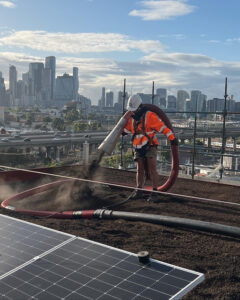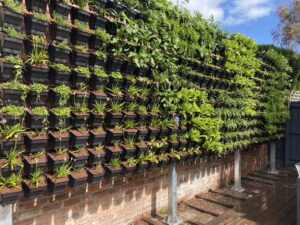
Exploring substrates – no substitution for future infrastructure projects
By Michael Casey
Substrates provide anchorage for plants and hold water which is key to their survival and growth through their effective absorption and storing of nutrients. Substrates, much like other living organisms, require a careful selection process to ensure they’re fit for purpose for green infrastructure projects.
Green infrastructure is a network of green spaces such as parks, gardens, wetlands and stream corridors, street trees and roadside verges, gardens and vegetable patches, bikeways and pedestrian trails, wall and rooftop gardens, and other natural areas that provide vast benefits for the environment and people’s wellbeing.
Green infrastructure solutions can cleanse the air and water, help with climate regulation, food provision, erosion control, and provide places for recreation to name a few. However, each solution has different requirements and processes to follow in their installation, and most, if not all, require a certain type of growing substrate to produce the most efficient outcomes.
Growing substrates are comprised of a mix of non-organic and organic components that can include scoria ash, pumice, sand, coir, pine bark, chemically inert foams, crushed bricks, and roof tiles, and all typically lack organic matter due to their rapid ability to break down and cause slumping in the constructed profile. The inclusion of organic matter may also become water repellant and hydrophobic making rewetting more difficult, especially if it’s used in roof spaces where environmental conditions are more prevalent. While it’s recognised that organic matter should be minimised in its usage, it can be added in low quantities (<20%) depending on the profile of the roof or planter, plant selection, and the weight loading of the project if applicable (i.e. greater amounts of water will be held in organic matter adding to the weight load).
To delve deeper into the seemingly complex world of growing substrates, there are a few examples of green infrastructure solutions that assist in understanding the basic requirements that need to be considered to produce the best outcomes possible.
Green roofs
Green roofs are typically separated into extensive (lightweight with a shallow layer of substrate less than 200mm) and intensive (heavier with a deeper layer of substrate), both of which require growing substrates that are more suited to their depths, drainage requirements, and plant selection. When designing green roofs and selecting the right substrate, the first aspect to address is the roof’s capacity to withstand weights applied to the construction. The saturated weight loading of a substrate, referred to as the saturated bulk density, refers to the growing substrate’s voids filled with water at saturation point. This bulk density can be managed by particle size and materials selected (scoria, sand, etc.), which all work at retaining and draining the available water, depending upon what’s required. The greater the particle size, the greater the pore space and the greater the drainage, all while providing a lighter substrate and lighter load. This lighter substrate may assist with weight loading but will reduce water holding capacity requiring more irrigation depending upon plant selection. Careful knowledge of plant choice, growing substrate mixes, infiltration rates, and profile depths will ensure the correct mix is selected. Taking it one step further, there’s a need to address irrigation to understand whether drip irrigation, either on surface or below (which would then account for capillary action), along with the options of sprayers, will all impact on the choice of substrate.
The basic understanding with substrates for roof applications is that the materials need to drain freely, not waterlog, retain enough water for plants to thrive, possess a high proportion of mineral components and low organic components. This, when specified correctly and along with correct plant choice, will all contribute to the successful outcomes of the roof garden. One important thing to note is in most cases is that substrates will need to be either lifted to the roof via a crane or similar lifting device in ‘bulka bags’ (large woven bags filled with materials) or blown to the roof via a truck mounted hopper. In most cases the use of manual labour to move growing substrates will rarely be an option.
If in doubt, or at times when further information is required, the many suppliers of substrates around Australia can provide specification sheets on their products to provide the technical advice required to make specifying easier. If the correct mix can’t be found, there are many experts in the soil industry who’d be eager to assist with projects to achieve the correct substrate blend.

Green walls
Green walls can be catergorised into two systems – hydroponic walls and substrate based walls, with the latter being explored here. The substrate based systems, and the many varieties available in market, will assist with how some substrates work better than others.
Substrate holding containers such as plastic, metal, or felt-like modular units, hold the substrate with irrigation that’s directly applied to each module, with the excess water draining through holes in the base of the container. As for roof gardens, the substrates used need to also be free draining, hold adequate moisture for plant health but be light enough to hang on walls, and more importantly, be supported by the construction it’s fixed to.
Suitable substrates must be able to provide and retain nutrients, and limit leaching out during regular irrigation cycles. A slow-release nutrient can also be added to the mix to ensure nutrients can be supplied for several months, therefore working as a replacement for organic matter (as mentioned earlier, this is to be avoided in our mixes). There is also the requirement to ensure the substrate is not retaining salts which is the byproduct of fertilisers breaking down. Careful post-maintenance can work at removing salts by flushing the growing substrate with potable clean water to reduce excessive levels.
Green walls, being on a vertical plane require irrigation from the top down, which can cause fluctuating moisture levels throughout the wall. The wall may hold higher levels of moisture in the lower sections of the wall where gravitational water drains to, and this will cause or lead to issues with plant selection and maintenance. Careful plant selection may assist with alleviating this issue. What may work more efficiently, to move water in the lower parts of the wall, is to change the ratio of substrate particle sizes therefore reducing the retention of water. The top of the wall can also become problematic with uneven moisture levels as this section is often exposed to the elements and can dry out faster, especially if the wall is installed outside. The use of a growing substrate that can retain more water (again changing the ratio of particle sizes in the substrate) in the containers at these heights will assist in retaining and providing adequate moisture to the plants.
Given green walls can be installed indoors and outdoors, the selection of growing substrates may be governed by aspect, wind, and sun conditions on the outside, and conditions such as heaters, air conditioners, doors opening or even distribution of light sources such as windows on the inside. The right substrate will again be governed by the amount of water required by the chosen plants for survival, the drainage throughout the wall, and ensuring a safe working weight load.
Coir, barks, mineral components, pumice, and vermiculite are all substrate additives that will work to ensure walls are healthy while working within these design parameters. As mentioned above there are several companies providing commercially mixed substrates for use in green walls, however, expert advice can also be obtained if specific mixes are needed.

Planter boxes
Planter boxes are now a familiar installation in the built environment with many multi-residential apartment buildings using in situ or manufactured planters in their construction. The use of these planters is a welcome addition, however, can present limitations and considerations mainly concerning the weight loading and their method of construction. Deep planters which can be built into buildings may not be suitable for shallow growing plants, and drainage will need to be sufficient to remove excess water from the substrate, and more importantly, the correct substrate and installation method all need to be addressed.
For deep planters that don’t require deep rooting plants, the planters can be established with the inclusion of void fillers that come in the form of polystyrene blocks or plastic structural void fillers. These fillers will allow for less substrate being used in the garden planter thus reducing weight and costs associated with materials and labour. The improvement in drainage will provide a positive outcome for the plants.
In the larger planters that require medium to larger plant life, that require deeper rooting, a substrate can be installed that provides an A and B horizon. These growing substrates need to be lightweight, free draining, and non-slumping to ensure they offer a reliable growing media for the present and into the future. These mixes are blended using high mineral matter which creates a structural framework that limits decomposition as this causes slumping, a loss in aeration, and affects drainage. By providing an A horizon that is free draining and non-slumping, the addition of a small amount of organic matter will aid in improving nutrient levels and can be managed to avoid the previously mentioned issues. The B horizon needs to be blended to suit installation below 300mm and should be free draining, non-slumping, and have very low organic matter levels. By using low levels of organic matter, the production of phytotoxic gases that accumulate as a result of anaerobic conditions, that exist from lower levels of oxygen in deeper profiles, can be avoided.
As we experience an increase and demand for more green infrastructure installations in our built environment, we need to ensure these projects last well into the future and provide the many benefits that nature provides, along with ensuring they can be easily maintained. The success of future projects start with thorough planning and the growing substrate should be the first item to address when specifying and planning that next installation. And as mentioned earlier, consult soil specialists and experts who are best placed to guide you on the right product/s.
Michael Casey,
Director of Evergreen Infrastructure and MJC Horticulture
Advisor to the green infrastructure industry.
E: michael@evergreeninfrastructure.com.au
Main photo: Growing substrate ‘blown’ onto roof garden by the use of a truck mounted hopper (Image: Michael Casey)
